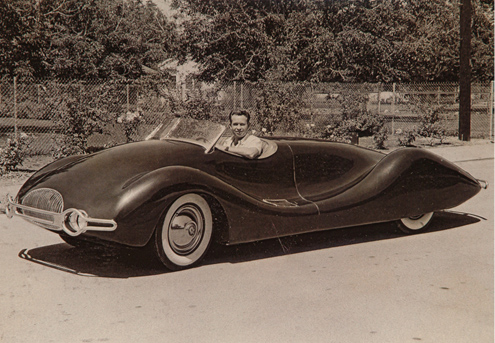Sometimes car designers manage to achieve the same effect as a well-written poem. With their masterpieces on wheels, they leave their signature and inspire the way cars will look for ages to come.
American automaker Norman Timbs was one of those who succeeded in putting his name in the hall of fame of iconic American car designs. His 1948 Buick Special Streamliner, which was restored in recent years, is one of the smoothest-looking classic cars in the world. It’s another perfect example that proves that doing things in a simple and streamlined way is often the best solution.
Norman Timbs was an American car engineer who used to work with Preston Tucker, the infamous owner of Tucker Automobiles (which made the Tucker 48 Sedan, later known as the Tucker Torpedo). Later in his career, Timbs focused on making Indy Racing Specials. He worked as an Indy 500 designer and constructed cars like the Blue Crown Specials. This successful series won the IndyCar grand prize multiple times.
The 1948 Norman Timbs Special. Norman Timbs was a Los Angeles-based mechanical auto engin.. https://t.co/neXabnuy8b pic.twitter.com/deXzUmr0yZ
— Historical Photos (@HiztoryPhotos) April 28, 2017
His elegant Buick Special Streamliner that we present to you here was completed in 1948. It took Timbs more than three years to design and create it. It all began on his drawing table: he first made some drawings of the chassis, and then he molded several slightly different quarter-scale clay models. Later, he made a wooden model that contained all of the design elements that he liked. The whole chassis was hand-crafted from high-quality aircraft tubing material, and the roadster’s aluminum body was hand-formed by Emil Diedt. Elements such as the brakes, steering, and a few other mechanical pieces were taken from a Mercury. As the driving force for his car, Timbs chose a 1948 Buick V8, an engine which was capable of pushing the 2200-pound car to up to 120 mph.
1948 Norman Timbs Special..uses 1948 Buick engine and running gear. The body and chassis custom made..✔✔✔ pic.twitter.com/zEbuFKzjY7
— Mary O’Donnell (@JOd1953) February 27, 2017
The final shape of the car (as seen today) had long, smooth curves and a complete underbelly panel. The engine was placed in the rear of the car, just behind the driver, with the whole cockpit slightly pushed forward. Because of Timbs’s intention to keep the airfoil wing shape of the car intact, there are no doors on the body. The whole design is seamless. There is a special hydraulic mechanism in the rear of the car, designed to lift the whole body when needed. When the button for the mechanism is pressed, the engine, spare tire, and fuel tank are revealed and easily accessible. The Norman Timbs Special is 47 inches high, from floor to the top of the windshield; its wheelbase is 117 inches and it is 18 feet long.
A muse in the world of classic cars!!! 1948 Buick Streamliner by Norman E. Timbs https://t.co/Cjh1OJ7gd2
— Clio Salakidou (@ClioASalakidou) January 25, 2017
Timbs took the inspiration for his design from a few pre-World War II Avus Grand Prix race cars, such as the Auto Union Type C and the Mercedes-Benz W25. He followed the same aerodynamic principles and design characteristics as in these old GP cars that used to go as fast as 248 mph. He made his roadster low, with long and flowing lines. Although it was designed in the image of the old racing cars, the Norman Timbs Special Streamliner was not made exclusively for the track; it was meant to hit the roads.
RT ValaAfshar: RT ValaAfshar: Is this one of the most beautiful cars in the world? 1948 Norman Timbs Special pic.twitter.com/vWVUVdRqpj
— Karthick Paulraj (@karthicktalks) November 27, 2016
The history of this car can be traced to the mid-1950s, when it was painted white and bought by Air Force Officer Jim Davis of Manhattan Beach, California. It looks like the car was later abandoned and left exposed to the harsh desert sun. It stayed there for years, until 2002, when it was found and sold by Barrett-Jackson at the Petersen Museum Classic Car Auction. The car was sold to Gary Cerveny of Malibu, California, who paid $17,600 for it and began a thorough restoration. Luckily, 90 percent of the original body of the roadster was intact and because of that, we can now enjoy its original appearance.
After it underwent a detailed restoration, the car made its debut at the 2010 Amelia Island Concours where it won the RM Auctions Trophy for the Best Open Car. It’s always important to keep an eye out for rare gems like this one and save them before time destroys them.
